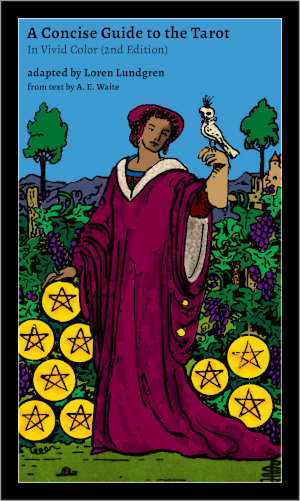Tarot Reading What lies in my future?
Reading Performed 10/11/2022 at 12:14 PM
Click or scroll down for the meaning of each position and the interpretation of its card.
Visual Layout
The Meanings of these Tarot Cards
Past
What has already occurred; the past.
The Devil from the Ancient Tarot of Lombardy Deck
A. E. Waite's Secondary Meanings
The Devil. In the eighteenth century this card seems to have been rather a symbol of merely animal impudicity. Except for a fantastic head-dress, the chief figure is entirely naked; it has bat-like wings, and the hands and feet are represented by the claws of a bird. In the right hand there is a sceptre terminating in a sign which has been thought to represent fire. The figure as a whole is not particularly evil; it has no tail, and the commentators who have said that the claws are those of a harpy have spoken at random. There is no better ground for the alternative suggestion that they are eagle's claws. Attached, by a cord depending from their collars, to the pedestal on which the figure is mounted, are two small demons, presumably male and female. These are tailed, but not winged. Since 1856 the influence of Eliphas Levi and his doctrine of occultism has changed the face of this card, and it now appears as a pseudo-Baphometic figure with the head of a goat and a great torch between the horns; it is seated instead of erect, and in place of the generative organs there is the Hermetic caduceus. In Le Tarot Divinatoire of Papus the small demons are replaced by naked human beings, male and female who are yoked only to each other. The author may be felicitated on this improved symbolism.
Present
What is occurring now; the present.
Strength from the Ancient Tarot of Lombardy Deck
A. E. Waite's Secondary Meanings
Justice. That the Tarot, though it is of all reasonable antiquity, is not of time immemorial, is shewn by this card, which could have been presented in a much more archaic manner. Those, however, who have gifts of discernment in matters of this kind will not need to be told that age is in no sense of the essence of the consideration; the Rite of Closing the Lodge in the Third Craft Grade of Masonry may belong to the late eighteenth century, but the fact signifies nothing; it is still the summary of all the instituted and official Mysteries. The female figure of the eleventh card is said to be Astraea, who personified the same virtue and is represented by the same symbols. This goddess notwithstanding, and notwithstanding the vulgarian Cupid, the Tarot is not of Roman mythology, or of Greek either. Its presentation of justice is supposed to be one of the four cardinal virtues included in the sequence of Greater Arcana; but, as it so happens, the fourth emblem is wanting, and it became necessary for the commentators to discover it at all costs. They did what it was possible to do, and yet the laws of research have never succeeded in extricating the missing Persephone under the form of Prudence. Court de Gebelin attempted to solve the difficulty by a tour de force, and believed that he had extracted what he wanted from the symbol of the Hanged Man--wherein he deceived himself. The Tarot has, therefore, its justice, its Temperance also and its Fortitude, but--owing to a curious omission--it does not offer us any type of Prudence, though it may be admitted that, in some respects, the isolation of the Hermit, pursuing a solitary path by the light of his own lamp, gives, to those who can receive it, a certain high counsel in respect of the via prudentiae.
Future
What has not yet occurred; the future.
The Traitor from the Ancient Tarot of Lombardy Deck
A. E. Waite's Secondary Meanings
The Hanged Man. This is the symbol which is supposed to represent Prudence, and Eliphas Levi says, in his most shallow and plausible manner, that it is the adept bound by his engagements. The figure of a man is suspended head-downwards from a gibbet, to which he is attached by a rope about one of his ankles. The arms are bound behind him, and one leg is crossed over the other. According to another, and indeed the prevailing interpretation, he signifies sacrifice, but all current meanings attributed to this card are cartomancists' intuitions, apart from any real value on the symbolical side. The fortune-tellers of the eighteenth century who circulated Tarots, depict a semi-feminine youth in jerkin, poised erect on one foot and loosely attached to a short stake driven into the ground.








